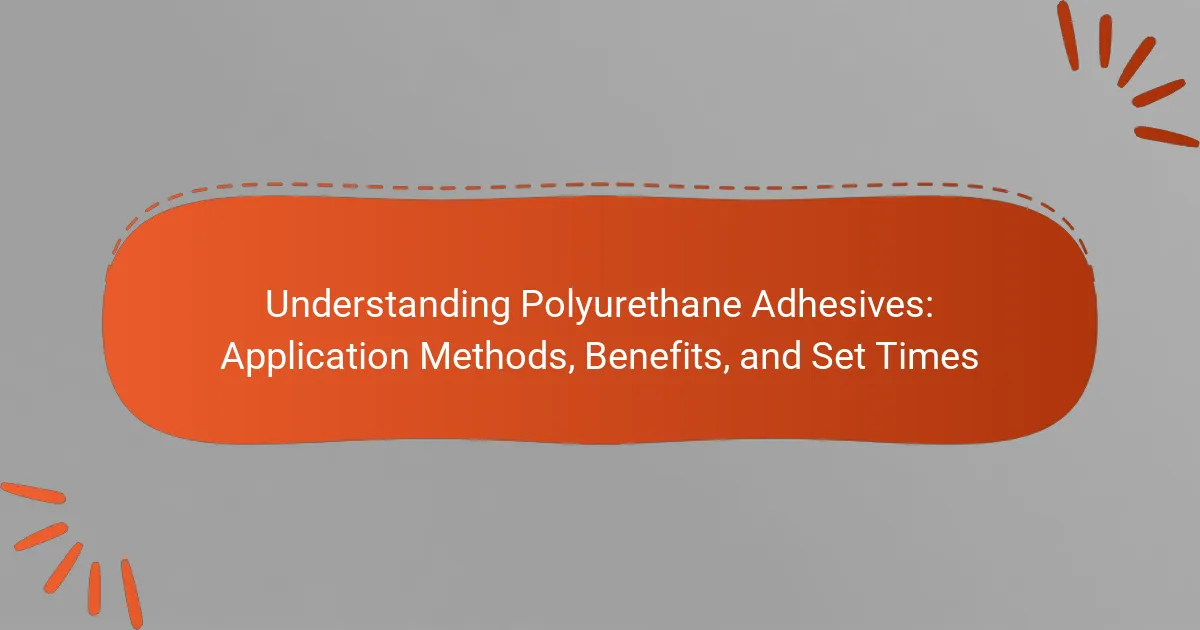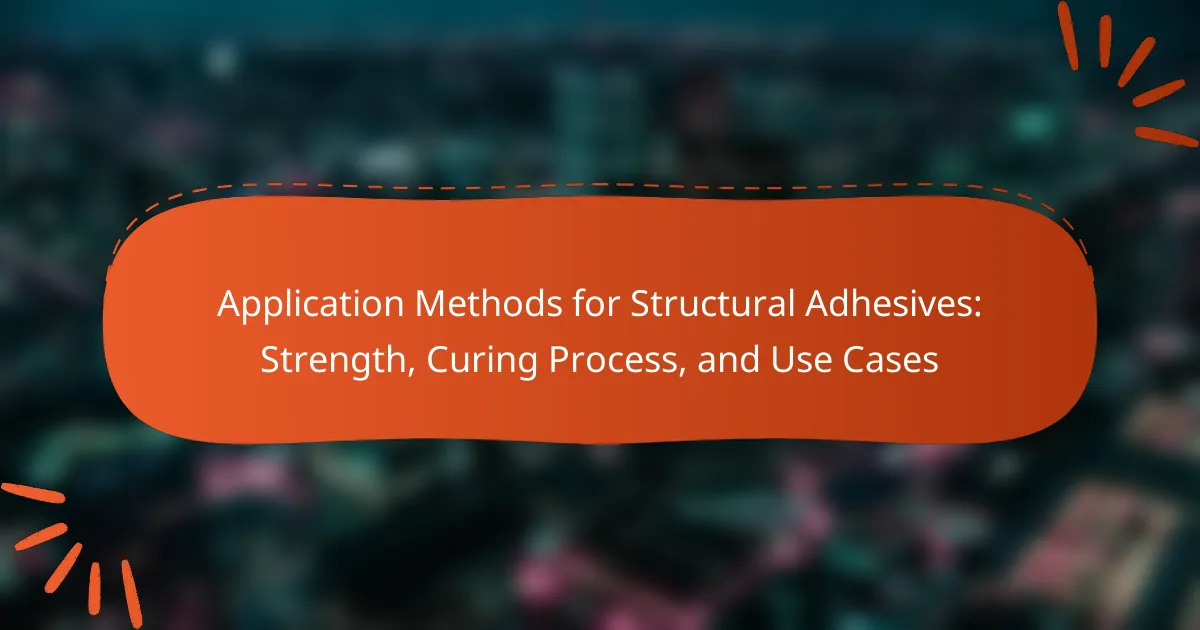Polyurethane adhesives are synthetic adhesives composed of polyurethane polymers, recognized for their strong bonding capabilities and versatility across various materials, including wood, metal, plastic, and ceramics. These adhesives cure in the presence of moisture and exhibit excellent resistance to heat, chemicals, and moisture, making them ideal for applications in construction and the automotive industry. With bonding strengths reaching up to 3,000 psi, polyurethane adhesives can also fill gaps, ensuring a tight seal in joints. The curing process typically ranges from 30 minutes to several hours, influenced by environmental conditions such as temperature and humidity, which affects both set and full cure times. This article explores the application methods, benefits, and specific set times of polyurethane adhesives.
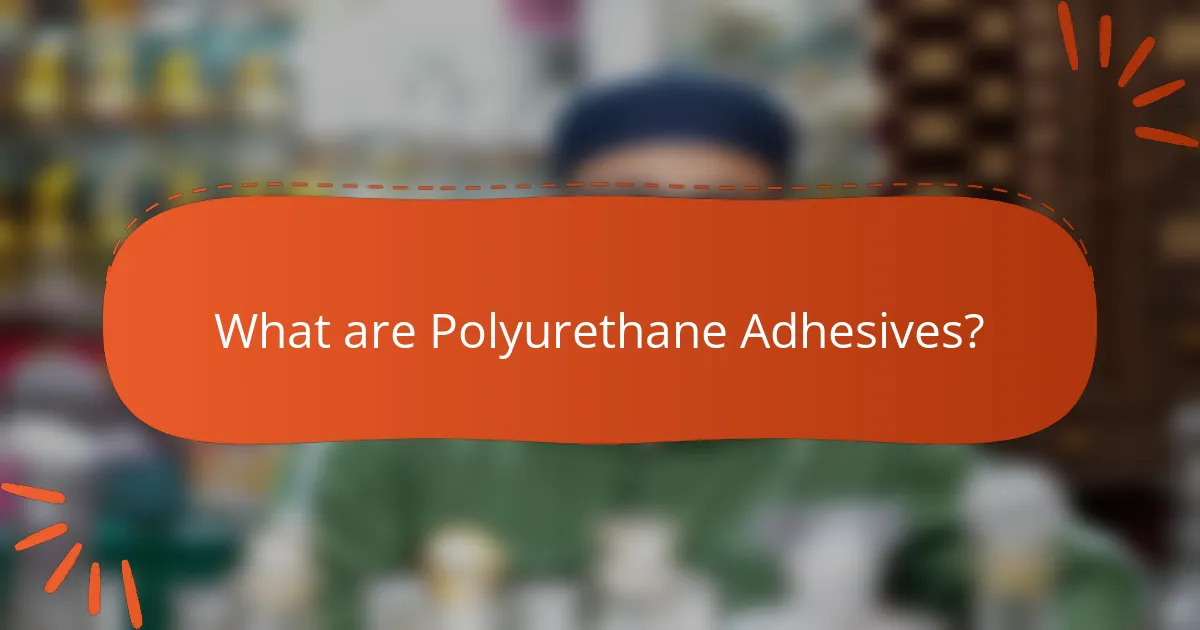
What are Polyurethane Adhesives?
Polyurethane adhesives are a type of synthetic adhesive made from polyurethane polymers. These adhesives are known for their strong bonding capabilities and versatility. They can bond a wide range of materials, including wood, metal, plastic, and ceramics. Polyurethane adhesives are moisture-curing, meaning they require humidity to set and cure effectively. They offer excellent resistance to heat, chemicals, and moisture, making them suitable for various applications. In construction, they are used for flooring, roofing, and insulation. In the automotive industry, they are utilized for bonding parts and components. Their ability to expand slightly during curing allows them to fill gaps and provide a tight seal.
How do Polyurethane Adhesives differ from other adhesives?
Polyurethane adhesives differ from other adhesives primarily in their chemical composition and bonding capabilities. They are versatile due to their ability to bond dissimilar materials, such as wood, metal, and plastic. Polyurethane adhesives create a strong, flexible bond that can withstand environmental stress and temperature fluctuations. Unlike some adhesives that cure quickly, polyurethane adhesives often require moisture to cure, which can affect their setting time. Their resistance to water and chemicals makes them suitable for both indoor and outdoor applications. Additionally, polyurethane adhesives exhibit excellent durability and impact resistance compared to traditional adhesives. These characteristics make them ideal for construction, automotive, and industrial uses.
What are the chemical properties of Polyurethane Adhesives?
Polyurethane adhesives are characterized by their unique chemical properties, which include versatility, strong bonding capabilities, and resistance to environmental factors. These adhesives are formed through the reaction of polyols and isocyanates. The resulting polymer exhibits excellent elasticity and flexibility. Polyurethane adhesives also demonstrate good adhesion to various substrates, including wood, metal, and plastics. Additionally, they possess resistance to moisture, chemicals, and temperature variations. Their curing process can be influenced by humidity and temperature, which affects the final properties. These adhesives can be formulated for specific applications, enhancing their performance in diverse environments.
What types of Polyurethane Adhesives are available?
There are several types of polyurethane adhesives available. They include one-component adhesives, which cure upon exposure to moisture. Two-component adhesives are also common; they require mixing before application. Structural polyurethane adhesives provide high strength for load-bearing applications. Flexible polyurethane adhesives allow for movement and are ideal for bonding dissimilar materials. Hot melt polyurethane adhesives are applied in a molten state and set quickly upon cooling. Each type serves specific applications based on their unique properties and performance characteristics.
What are the primary applications of Polyurethane Adhesives?
Polyurethane adhesives are primarily used in construction, automotive, and furniture industries. In construction, they bond various materials like wood, metal, and concrete. In the automotive sector, they are utilized for assembling parts and sealing joints. Furniture manufacturers use these adhesives for assembling and finishing products. Additionally, they are effective in applications requiring flexibility and durability. Their resistance to moisture and temperature changes makes them suitable for outdoor use. Polyurethane adhesives also excel in bonding dissimilar materials, enhancing their versatility.
In which industries are Polyurethane Adhesives commonly used?
Polyurethane adhesives are commonly used in various industries including construction, automotive, aerospace, furniture, and footwear. In construction, they bond materials like wood, metal, and concrete. The automotive industry utilizes these adhesives for assembling vehicle components and interior fittings. Aerospace applications include bonding lightweight materials for aircraft. In furniture, polyurethane adhesives are used for laminating and assembling wooden products. Footwear manufacturers rely on these adhesives for durable bonding of different materials.
What are the specific applications of Polyurethane Adhesives in construction?
Polyurethane adhesives are widely used in construction for various applications. They bond materials such as wood, metal, concrete, and plastics effectively. These adhesives provide strong, flexible, and durable joints. They are suitable for both interior and exterior applications. Polyurethane adhesives are resistant to moisture and temperature fluctuations. This makes them ideal for flooring installations and roofing systems. They are also used in assembling prefabricated structures. Additionally, they are effective in sealing joints and gaps in construction projects. Their versatility enhances the structural integrity of buildings.
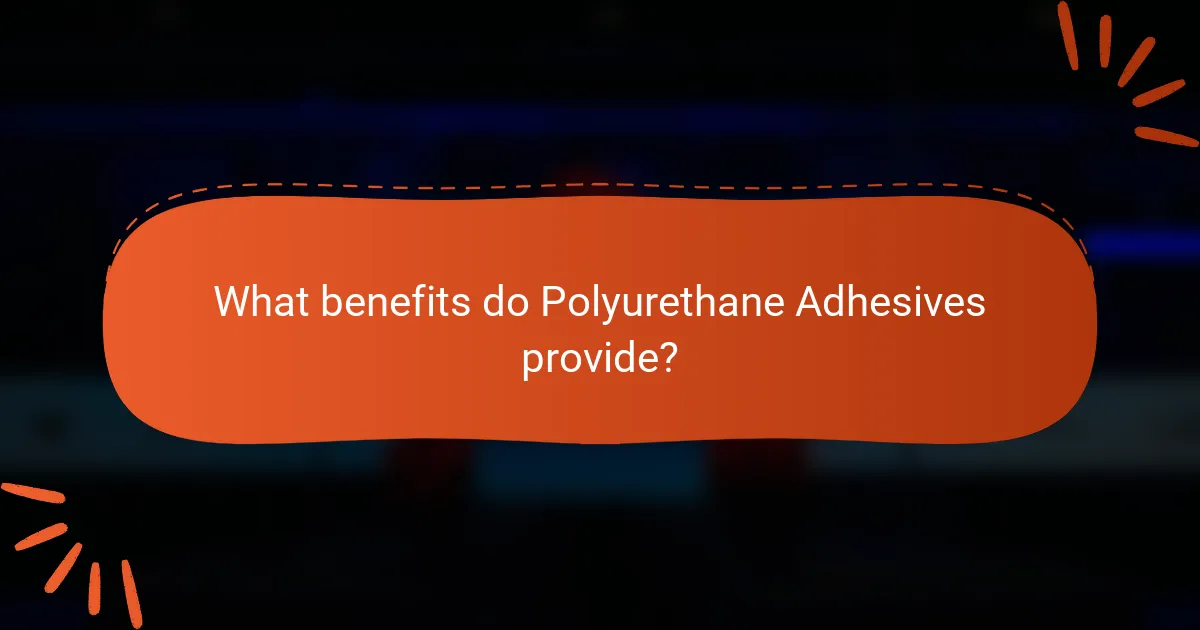
What benefits do Polyurethane Adhesives provide?
Polyurethane adhesives provide strong bonding capabilities across various materials. They offer excellent adhesion to wood, metal, plastic, and ceramics. These adhesives are known for their flexibility, allowing for movement without cracking. They also exhibit resistance to moisture, chemicals, and temperature changes. Polyurethane adhesives can cure in a wide range of conditions, enhancing their versatility. Their durability makes them suitable for both indoor and outdoor applications. The bonding strength can reach up to 3,000 psi, ensuring reliable performance. Additionally, they can fill gaps, providing a complete seal in joints.
How do Polyurethane Adhesives enhance bonding strength?
Polyurethane adhesives enhance bonding strength through their unique chemical composition and curing process. These adhesives form strong covalent bonds with various substrates, including wood, metal, and plastics. The moisture-curing mechanism allows them to expand and fill gaps, improving contact area and adhesion. Additionally, they exhibit excellent flexibility and resistance to environmental factors, which contributes to long-lasting bonds. Studies show that polyurethane adhesives can achieve bond strengths exceeding 3000 psi in specific applications. This high-performance capability makes them suitable for demanding environments.
What factors contribute to the durability of Polyurethane Adhesives?
The durability of polyurethane adhesives is influenced by several key factors. These include chemical composition, moisture resistance, temperature stability, and bonding surface preparation. The chemical composition determines the adhesive’s strength and flexibility. Moisture resistance is crucial for applications exposed to water or humidity. Temperature stability ensures performance in varying thermal conditions. Proper bonding surface preparation enhances adhesion and longevity. Research indicates that these factors collectively enhance the lifespan and effectiveness of polyurethane adhesives in diverse applications.
How do Polyurethane Adhesives perform in extreme conditions?
Polyurethane adhesives exhibit strong performance in extreme conditions. They maintain flexibility and bond strength in both high and low temperatures. These adhesives resist moisture and chemicals, making them suitable for harsh environments. For instance, they can withstand temperatures ranging from -40°F to 200°F. Their durability is evident in applications like automotive and construction. Research shows that polyurethane adhesives retain their properties under cyclic temperature changes. This resilience ensures long-lasting bonds even in challenging conditions.
Why are Polyurethane Adhesives considered versatile?
Polyurethane adhesives are considered versatile due to their ability to bond a wide variety of materials. They can effectively adhere to wood, metal, plastic, and ceramics. This broad compatibility makes them suitable for diverse applications across industries. Polyurethane adhesives also exhibit strong resistance to moisture, heat, and chemicals. Their flexibility allows them to absorb stresses without cracking. Additionally, they can be formulated to cure at different rates, providing options for various project timelines. These attributes contribute to their widespread use in construction, automotive, and furniture manufacturing sectors.
What substrates can Polyurethane Adhesives bond effectively?
Polyurethane adhesives can effectively bond a variety of substrates. These include wood, metal, plastics, ceramics, and concrete. The strong adhesion properties of polyurethane make it suitable for both porous and non-porous materials. It can also bond dissimilar materials, which is beneficial in many applications. Studies show that polyurethane adhesives provide excellent tensile strength and flexibility. This makes them ideal for construction, automotive, and manufacturing industries.
How do Polyurethane Adhesives accommodate different environmental conditions?
Polyurethane adhesives accommodate different environmental conditions through their versatility and adaptability. They maintain strong bonding capabilities in varying temperatures and humidity levels. These adhesives cure through a chemical reaction with moisture in the air. This property allows them to perform well in both dry and damp environments. Additionally, they exhibit resistance to chemicals and UV exposure. This resistance ensures durability in harsh outdoor conditions. Their flexibility also allows for movement between bonded materials, reducing the risk of failure. Overall, polyurethane adhesives are engineered to function effectively across a wide range of environmental factors.
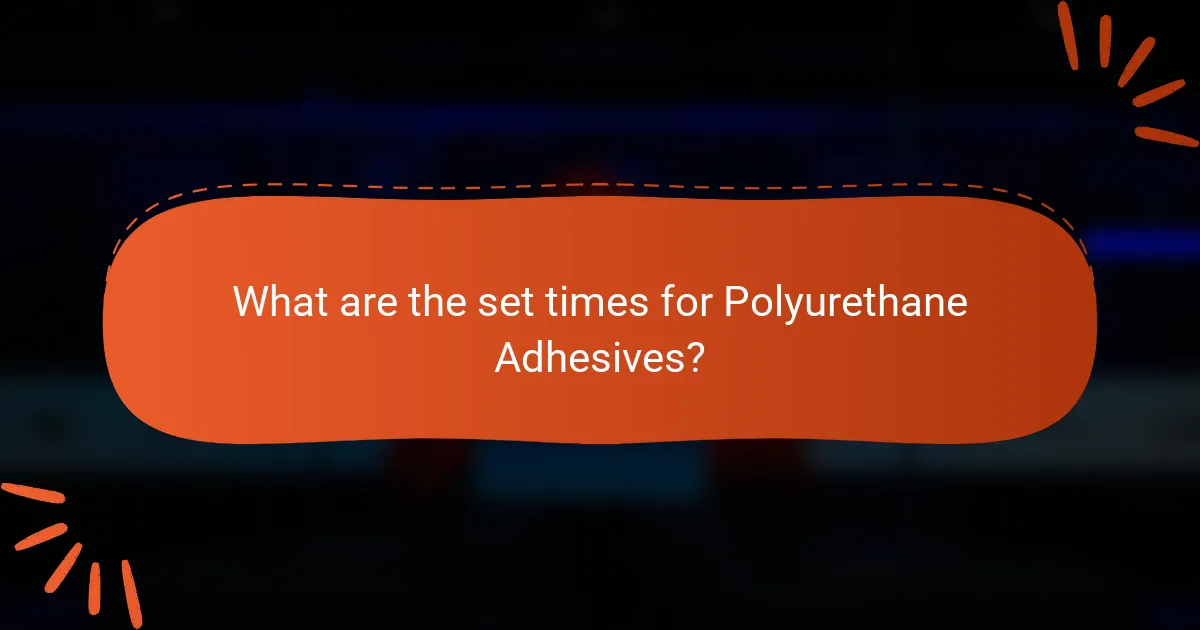
What are the set times for Polyurethane Adhesives?
Polyurethane adhesives typically have set times ranging from 30 minutes to several hours. The initial set time is often around 30 minutes to 1 hour. Full cure can take up to 24 hours or more, depending on the specific formulation and environmental conditions. Factors such as temperature and humidity can influence these times. For example, warmer temperatures can accelerate the curing process. Conversely, lower temperatures may prolong it. Always refer to the manufacturer’s guidelines for precise set times for specific products.
How does the curing process of Polyurethane Adhesives work?
The curing process of polyurethane adhesives involves a chemical reaction between the adhesive components. This reaction typically requires moisture from the environment or the substrates being bonded. As the reaction occurs, the adhesive transitions from a liquid to a solid state, forming a strong bond.
The curing time can vary based on factors such as temperature and humidity. Higher temperatures and increased moisture levels generally accelerate the curing process. The full curing process may take several hours to days, depending on the specific formulation of the adhesive.
Polyurethane adhesives are known for their excellent adhesion to a variety of materials, including wood, metal, and plastics. This versatility makes them popular in construction and manufacturing applications. The final bond strength is often greater than the materials being joined, demonstrating the effectiveness of the curing process.
What factors influence the set time of Polyurethane Adhesives?
The set time of polyurethane adhesives is influenced by several factors. Temperature plays a crucial role; higher temperatures generally accelerate the curing process. Humidity also affects set time; increased moisture can enhance the curing speed of certain formulations. The specific formulation of the adhesive is important; different ratios of components can lead to varied set times. Surface preparation impacts adhesion and curing; clean, rough surfaces can facilitate faster bonding. Finally, the presence of catalysts can significantly reduce set time by promoting chemical reactions. These factors collectively determine how quickly polyurethane adhesives reach their optimal bond strength.
What are the typical set times for different types of Polyurethane Adhesives?
Typical set times for polyurethane adhesives vary by type. One-component polyurethane adhesives generally set in 24 hours. Two-component polyurethane adhesives typically set within 1 to 4 hours after mixing. Fast-setting polyurethane adhesives can cure in as little as 30 minutes. Factors such as temperature and humidity can influence these times. For example, higher temperatures may accelerate the curing process. Conversely, lower temperatures can prolong set times. The specific product instructions should always be consulted for accurate timing.
What best practices should be followed when using Polyurethane Adhesives?
Use polyurethane adhesives in a well-ventilated area to ensure safety. Proper ventilation reduces exposure to harmful fumes. Clean surfaces thoroughly before application to enhance adhesion. This ensures that contaminants do not interfere with bonding. Apply the adhesive evenly to avoid weak spots. Uneven application can lead to bond failure. Follow the manufacturer’s instructions for curing times. Each product may have specific requirements for optimal performance. Use appropriate personal protective equipment, such as gloves and goggles. This minimizes the risk of skin and eye irritation. Store adhesives in a cool, dry place to prolong shelf life. High temperatures can degrade adhesive quality. Dispose of unused adhesive according to local regulations. Proper disposal prevents environmental contamination.
How can users ensure optimal bonding with Polyurethane Adhesives?
Users can ensure optimal bonding with polyurethane adhesives by following specific preparation and application techniques. First, they should clean the surfaces to remove dust, grease, and moisture. This enhances adhesion by promoting a stronger bond. Next, users should roughen the surfaces using sandpaper or a similar tool. This increases the surface area for the adhesive to grip.
Applying the adhesive evenly is crucial. Users should use a suitable applicator to spread the adhesive uniformly. Following the manufacturer’s instructions on the adhesive’s open time and curing time is essential. This ensures that the adhesive sets properly and achieves maximum strength.
Lastly, users should clamp the bonded surfaces during the curing process. This maintains contact and prevents movement, which can weaken the bond. Properly executed, these steps lead to effective bonding with polyurethane adhesives.
What common troubleshooting tips exist for Polyurethane Adhesives?
Ensure surfaces are clean and dry before application. Contaminants can impede adhesion. If the adhesive does not bond, check for proper mixing ratios. Incorrect ratios can lead to ineffective curing. For slow curing, consider temperature and humidity levels. Polyurethane adhesives require specific conditions to cure effectively. If bubbles appear, avoid excessive mixing. Over-mixing can introduce air into the adhesive. If the bond fails, inspect the materials being joined. Some materials may not be compatible with polyurethane adhesives. Always follow the manufacturer’s instructions for best results.
Polyurethane adhesives are synthetic adhesives known for their strong bonding capabilities and versatility, able to bond materials such as wood, metal, plastic, and ceramics. This article provides an in-depth exploration of polyurethane adhesives, including their chemical properties, types, and primary applications across various industries like construction and automotive. Key benefits, such as moisture and chemical resistance, durability, and flexibility, are highlighted alongside factors influencing their set times and curing processes. Best practices for optimal bonding and troubleshooting tips are also discussed to aid users in effectively utilizing these adhesives.
